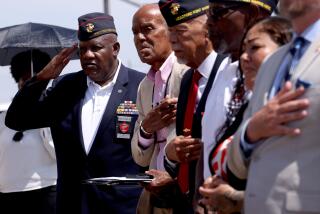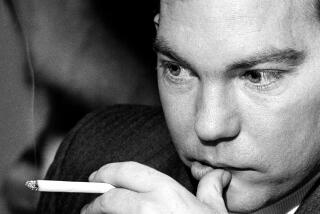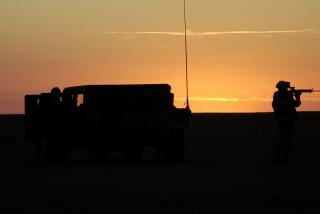Marine received Navy Cross for heroism in Vietnam
- Share via
Retired Marine Corps Col. John W. Ripley, a Vietnam war hero who was awarded the Navy Cross for risking his life to blow up a strategic Highway 1 bridge that halted the advance of North Vietnamese troops and tanks during the 1972 Easter Offensive, has died. He was 69.
Ripley was found dead Saturday at his home in Annapolis, Md., said his son, Stephen Ripley, who believes that his father died in his sleep four nights earlier.
He said his father had received a liver transplant seven years ago, but his recent health had been good.
“He was the closest thing we had to a living legend, and he will be remembered far into the future,” said John Grider Miller, a retired Marine colonel and author who worked closely with Ripley while writing the 1989 book “The Bridge at Dong Ha.”
It’s the story, Miller said, “of one man, one bridge, one day.”
“I really got into Ripley’s head as he moved through that day,” Miller said. “He woke up that morning convinced he would not live through the day.”
Then a 32-year-old captain on his second tour of duty in Vietnam, Ripley was the senior advisor to a battalion of South Vietnamese Marines in 1972.
They had been sent to Dong Ha near the demilitarized zone to take defensive positions along the south bank of the Cua Viet River at the start of the North Vietnamese offensive.
On Easter Sunday, Ripley received word that the vanguard of the North Vietnamese Army -- 20,000 troops and 200 tanks -- was moving down Highway 1 toward the bridge.
“Ripley realized he couldn’t stop these guys with 600 Marines, and if the North Vietnamese got across the bridge, the South Vietnamese were all dead,” Miller said. “So he decided to blow the bridge.”
He did it by positioning five boxes of TNT -- and plastic explosives to detonate the TNT -- along the bridge: an approximately 600-foot-long steel structure with steel-reinforced concrete supports.
After swinging hand-over-hand along the outside girder of the bridge, Ripley swung up into the first of five channels created by adjacent girders and crawled back through the channel toward the shoreline.
He then began pulling out the first 100-pound box of TNT and plastic explosives that had been placed in the channel by U.S. Army Maj. Jim Smock.
It took Ripley about three hours to position the heavy boxes of explosives along the bridge’s five different channels and set the fuses.
And, Miller said, “any time Ripley dropped down one channel to swing to another channel, he was exposed to direct fire.”
At one point, an enemy tank fired a round from its main gun at Ripley. But, Miller said, the round hit the bridge before it was armed and ricocheted to the south bank, where it exploded.
As Ripley worked, Miller said, he was “very highly focused on just doing his job. He knew that this had to be done and that he was the only one who could do it.”
“He had that quality of accepting his own potential death to do what had to be done.”
In a videotaped interview for the U.S. Naval Institute’s “Americans at War” documentary series, Ripley said that “the idea that I would be able to even finish the job before the enemy got me was ludicrous.”
“When you know you’re not gonna make it, a wonderful thing happens: You stop being cluttered by the feeling that you’re going to save your butt.”
When he was finished, the exhausted Ripley pulled himself hand over hand under the bridge and back to shore under enemy fire.
In his Naval Institute interview, Ripley said that when “the time fuses detonated, all of a sudden the shock wave picked me up from behind. It just blew me through the air, and I’m lying on my back looking skyward, and I can see enormous chunks of this bridge blowing through the air. It was a tremendous feeling.”
In blowing up the bridge, Miller said, Ripley “stalled the armored attack, and the NVA had to move inland to seek another crossing site. That gave the South Vietnamese defenders time to organize the defense on a line farther south and that line held so the enemy, even after they crossed the river, never got below the northernmost province.”
For his actions at the bridge at Dong Ha, Ripley received the Navy Cross, the second-highest decoration that the country gives for heroism.
“A lot of people think he should have had the Medal of Honor,” Miller said.
He said Ripley’s heroic feat is taught to midshipmen at the Naval Academy, where Ripley has been memorialized with a large diorama at the entrance to Memorial Hall titled, “Ripley at the Bridge.”
During his career in the Marines, Ripley completed training in four of the toughest military programs in the world: Marine Corps’ Force Reconnaissance, Army Rangers, Army Airborne and Britain’s Royal Marines Commando.
In June, he became the first Marine inducted into the U.S. Army Ranger Hall of Fame at Ft. Benning, Ga.
Born in Radford, Va., on June 29, 1939, Ripley enlisted in the Marine Corps after graduating from high school in 1956.
He was appointed to the U.S. Naval Academy and graduated in 1962 with a bachelor’s degree in electrical engineering.
In addition to his tour as an advisor in Vietnam in the early 1970s, Ripley served an earlier tour as a company commander with the 3rd Battalion, 3rd Marines, during which he received a Purple Heart.
Among his other awards were the Silver Star, two Legion of Merit awards and two Bronze Stars with combat Vs for valor.
After his second tour in Vietnam, he served in multiple billets, including tours as a battalion commander and a regimental commander.
During the 1980s, he drew on his Royal Marine training to teach Marines how to fight in the Arctic and subsequently led a Marine battalion in joint training with the Norwegians in the Arctic.
After retiring from the Marines in 1990, he was president and chancellor of what it is now called Southern Virginia University in Lexington, Va., and he was president of Hargrave Military Academy in Chatham, Va.
He then served as director of the Marine Corps History and Museums Division and the Marine Corps Historical Center.
In addition to his son Stephen, Ripley is survived by his wife, Moline; two other sons, John and Thomas; a daughter, Mary Ripley; a sister, Susan Goodykoontz; and eight grandchildren.
A funeral service will be held at noon Friday at the U.S. Naval Academy Chapel.
Instead of flowers, the family requests that donations be made to the Marine Corps Law Enforcement Foundation, www.mc-lef.org.
--
More to Read
Sign up for Essential California
The most important California stories and recommendations in your inbox every morning.
You may occasionally receive promotional content from the Los Angeles Times.










